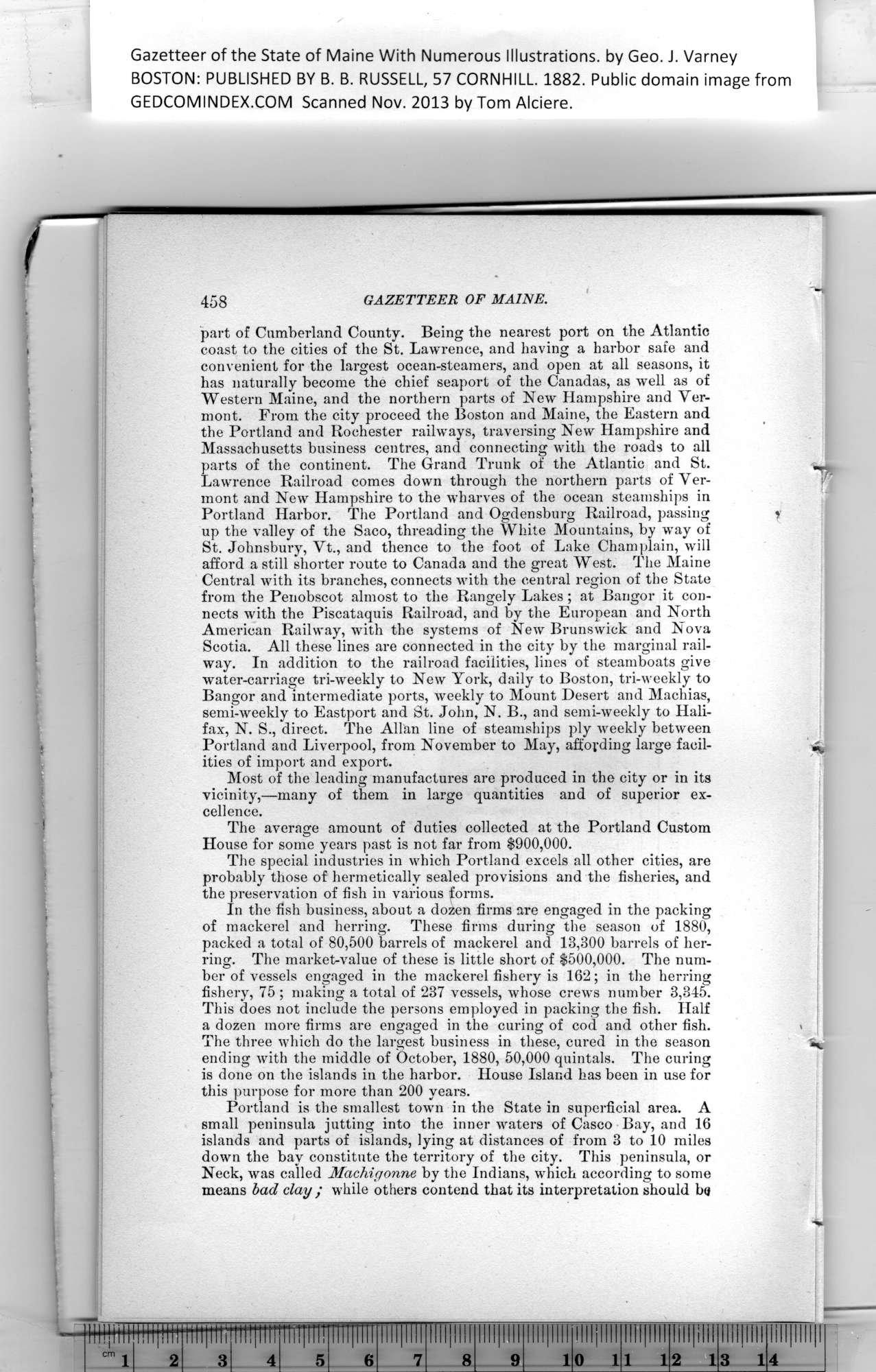|
Gazetteer of the State of Maine With Numerous Illustrations, by Geo. J. Varney
BOSTON: PUBLISHED BY B. B. RUSSELL, 57 CORNHILL. 1882. Public domain image from
458 GAZETTEER OF MAINE.
part of Cumberland County. Being the nearest port on the Atlantic
coast to the cities of the St. Lawrence, and having a harbor safe and
convenient for the largest ocean-steamers, and open at all seasons, it
has naturally become the chief seaport of the Canadas, as well as of
Western Maine, and the northern parts of New Hampshire and Ver-
mont. From the city proceed the Boston and Maine, the Eastern and
the Portland and Rochester railways, traversing New Hampshire and
Massachusetts business centres, and connecting with the roads to all
parts of the continent. The Grand Trunk of the Atlantic and St.
Lawrence Railroad comes down through the northern parts of Ver-
mont and New Hampshire to the wharves of the ocean steamships in
Portland Harbor. The Portland and Ogdensburg Railroad, passing *•
up the valley of the Saco, threading the White Mountains, by way of
St. Johnsbury, Vt., and thence to the foot of Lake Champlain, will
afford a still shorter route to Canada and the great West. The Maine
Central with its branches, connects with the central region of the State
from the Penobscot almost to the Rangely Lakes ; at Bangor it con-
nects with the Piscataquis Railroad, and by the European and North
American Railway, with the systems of New Brunswick and Nova
Scotia. All these lines are connected in the city by the marginal rail-
way. In addition to the railroad facilities, lines of steamboats give
water-carriage tri-weekly to New York, daily to Boston, tri-weekly to
Bangor and intermediate ports, weekly to Mount Desert and Machias,
semi-weekly to Eastport and St. John, N. B., and semi-weekly to Hali-
fax, N. S., direct. The Allan line of steamships ply weekly between
Portland and Liverpool, from November to May, affording large facil-
ities of import and export.
Most of the leading manufactures are produced in the city or in its
vicinity,—many of them in large quantities and of superior ex-
cellence.
The average amount of duties collected at the Portland Custom
House for some years past is not far from $900,000.
The special industries in which Portland excels all other cities, are
probably those of hermetically sealed provisions and the fisheries, and
the preservation of fish in various forms.
In the fish business, about a dozen firms are engaged in the packing
of mackerel and herring. These firms during the season of 1880,
packed a total of 80,500 barrels of mackerel and 13,300 barrels of her-
ring. The market-value of these is little short of $500,000. The num-
ber of vessels engaged in the mackerel fishery is 162; in the herring
fishery, 75 ; making a total of 237 vessels, whose crews number 3,345.
This does not include the persons employed in packing the fish. Half
a dozen more firms are engaged in the curing of cod and other fish.
The three which do the largest business in these, cured in the season
ending with the middle of October, 1880, 50,000 quintals. The curing
is done on the islands in the harbor. House Island has been in use for
this purpose for more than 200 years.
Portland is the smallest town in the State in superficial area. A
small peninsula jutting into the inner waters of Casco Bay, and 16
islands and parts of islands, lying at distances of from 3 to 10 miles
down the bay constitute the territory of the city. This peninsula, or
Neck, was called Machigonne by the Indians, which according to some
means bad clay ; while others contend that its interpretation should bg
PREVIOUS PAGE ... NEXT PAGE
This page was written in HTML using a program written in Python 3.2
|
